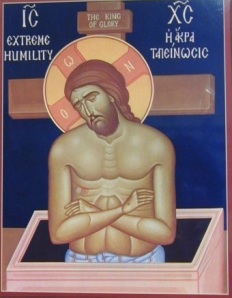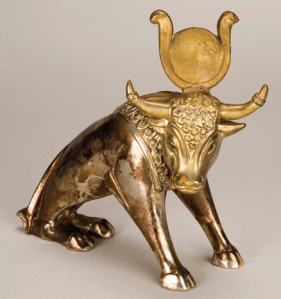Do not think about a golden calf.
Whatever you do,
do not think about a golden calf.
Stop thinking about golden calves.
What are you thinking about right now?
It is impossible to drive away unwanted thoughts by focusing on “what not to think”. The more you say, “Don’t think about a golden calf”, the more firmly the vision of a golden calf remains in your mind.
Now, mentally picture an icon of Jesus.
Imagine a painting of Jesus, hanging on the cross.
Imagine the suffering He endured for the sake of your salvation.
While thinking of Jesus, you were not thinking of golden calves anymore, were you?
The only effective way to drive away unwanted thoughts, is not merely to negate them,
but rather to replace them with other thoughts which cancel them out.
(This same illustration could be made in regard to other sins, such as lust or murder.
But I do not wish to subject the reader to those sorts of mental images.)
Historically, one of the most visually-oriented sins is idolatry. People look into the golden or wooden eyes of a statue that has been carved into the image of a pagan god. They kiss the image, light a candle, and maybe even burn some incense to worship it. I have seen this blatant form of idolatry myself while walking the streets of Kathmandu, in Nepal, and it makes for a surreal sense of wickedness. It is not unlike the overt idolatry the apostles fought against in ancient pagan Rome.
And these idols are not only found in the Far East. Here in America, a trip to your local Chinese restaurant is likely to bring you in contact with a statue of the Buddha, or with one of myriad statues of Hindu deities. The demonic presence of idolatry is among us.
What is the best way to combat idolatry? If a person finds himself tempted to worship a pagan god, what is the most effective way to fight against the urge?
At least one bad strategy would be to walk around saying, “Don’t worship the Buddha. Don’t worship the Buddha.” You can’t avoid thinking of something, by focusing on “what not to think”.
Even if you remove all pagan statues from your presence, memories of their images are liable to pop up in your mind at any time. So even mere “avoidance” will not be entirely effective.
A much better solution is to replace the negative with something positive.
Remove the image that is wicked, and introduce an image that is holy.
Replace the vile image with a godly image.
This is precisely what God did with the Israelites in the book of Exodus.
For centuries, they had been surrounded by the pagan idols of Egypt.
Then, even after the miraculous Red Sea crossing, they made a golden calf idol.
To make this pagan idol, the Israelites gave up freewill offerings, melting down some of their earrings and other jewelry, in order to make this unholy image. (Exodus 32)
Then, three chapters later, the Israelites again give freewill offerings of their earrings and jewelry. They again melt down gold so they can make graven images to use in the context of worship. Except this time, the Lord God is well pleased with them:
They came, both men and women, as many as had a willing heart, and brought earrings and nose rings, rings and necklaces, all jewelry of gold, that is, every man who made an offering of gold to the Lord. . . . He made two cherubim of beaten gold; he made them of one piece at the two ends of the mercy seat: one cherub at one end on this side, and the other cherub at the other end on that side. He made the cherubim at the two ends of one piece with the mercy seat. The cherubim spread out their wings above, and covered the mercy seat with their wings. They faced one another; the faces of the cherubim were toward the mercy seat. . . . Then the cloud covered the tabernacle of meeting, and the glory of the Lord filled the tabernacle.
(Exodus 35:22, 37:7-9, 40:34)
God did not command the Israelites to replace their pagan images with blank walls.
Rather, God commanded them to replace their pagan images with holy images of angels.
In 1 Corinthians 10, the apostle Paul tells us twice that the Israelites’ stories are written for our example, and for our instruction. Then St. Paul warns us:
“Therefore, my beloved, flee from idolatry.”
(1 Corinthians 10:14)
 What is the best way for us to flee? The same way God taught the Israelites to flee.
What is the best way for us to flee? The same way God taught the Israelites to flee.
We do not flee from idolatry by avoiding images altogether. We do not merely try to blank out our minds, thinking of “nothing in particular” when we have thoughts about God.
Such attempts are spiritually dangerous. If a person avoids all images of Jesus, that person risks falling into idolatry by implicitly denying the incarnation. If a person does not bow to an icon of Christ, he risks bowing down to a faceless idol, as the following article warns:
https://theorthodoxlife.wordpress.com/2012/04/09/bowing-down-to-a-faceless-idol/
We cannot effectively combat idolatry by avoiding religious images. Rather, we replace images of pagan gods with holy images of the true God, for holy images are the very opposite of idolatry. Christian icons–holy images of Jesus and the saints–are one of the most effective tools in defeating idol-worship.
We conquer idols with icons.
~
This is day thirty-one of the 40 Days of Blogging.
For more articles on idolatry, check out these bloggers.



I liked this post very much. I agree with your point of view. Many Protestants take so many things in the Bible so literally. They don’t understand the decrees of the 7th Ecumenical Council, either. We think of all of the great things God has done for us by looking at holy images, and praying before them. It’s indeed commanded by God.